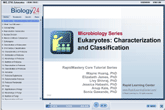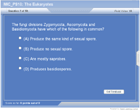| How to Learn in 24 Hours? |
|
| Need Help? |
M-F: 9am-5pm(PST):
Toll-Free: (877) RAPID-10
or 1-877-727-4310
24/7 Online Technical Support:
The Rapid Support Center
vip@rapidlearningcenter.com
Secure Online Order:

|
| Tell-A-Friend: |
Have friends taking science and math courses too? Tell them about our rapid learning system.
|
|
The Eukaryotes: Fungi, Algae, Protozoa and Helminths
| Topic Review on "Title": |
- The DNA in eukaryotes is complexed with histones which are proteins. Eukaryote chromosomes and complexed proteins form chromatin and is located in the cells nucleus.
- Some eukaryotic DNA can be found in chloroplasts and mitochondria. These organelles reproduce by binary fission.
- Eukaryote asexual reproduction includes: binary fission, budding, fragmentation, spore formation and schizogony.
- Sexual reproduction involves the formation of gametes. Fusions of gametes and formation of a zygote.
- Algae, fungi and some protozoa reproduce both sexually and asexually
- In meiosis a diploid parent cell creates four haploid daughter cells. The DNA has usually undergone some crossing over so the chromosomes are not only halved but are also changed through rearrangement.
- Mitosis: Cells have two main stages in the life cycle. Interphase: the cells grow and duplicate their DNA, in the second stage the cell’s nucleus divides. In mitosis nuclear division starts after the cell has duplicated its DNA. The result is two exact copies of the DNA.
- One of each copy goes to the new cells nucleus. Mitosis maintains the ploidy of a cell. That is a haploid nucleus undergoing mitosis creates two identical cells each with a haploid nucleus. A diploid nucleus undergoing mitosis creates two identical cells each with a haploid nucleus.
- Asexual reproduction, in which a cell undergoes multiple mitoses creating a multinucleate cell is called a schizont. This multinucleate cell then simultaneously releases many uninucleate daughter cells called merozoites. Plasmodium, which causes malaria, reproduces this way inside red blood cells and within the liver. The huge release of merozoites results in the cyclic fever and chills associated with malaria.
- Modern (early) 21st century classification is based on DNA and protein sequence information. This information combined with existing taxonomic information has resulted in new divisions and classifications. The kingdom Protista was reclassified into several new kingdoms: Alveolata, Euglenozoa, Diplomonadida and Parabasala. In the current classification scheme Algae are distributed in the kingdoms: Stramenophila and Rhodophyta and Plantae. Water molds belong to the kingdom of Stramonophila and slime molds are in the kingdom Mycetozoa.
|
| Rapid Study Kit for "Title": |
| Flash Movie |
Flash Game |
Flash Card |
| Core Concept Tutorial |
Problem Solving Drill |
Review Cheat Sheet |
 |
 |
 |
|
| "Title" Tutorial Summary : |
The taxonomy and classification of the eukaryotes: fungi, algae, protozoa and helminths (parasitic worms e.g. tapeworms, flukes) are introduce. Meiosis (sexual reproduction) is presented in a step by step process and contrasted with mitosis.
21st and 20th Century classification methods are compared and contrasted and applied to eukaryotes.
|
| Tutorial Features: |
Specific Tutorial Features:
- Meiosis and Mitosis are described in a detailed step by step process.
- Protozoa nutrition reproduction and classification is described.
- Fungus morphology, nutrition, reproduction and classification is examined and described.
- Algae as a group are examined and described in detail. The classification and unique niches these organisms live in are explored. The essential contribution that algae make to oxygen is introduced.
- Eukaryotes have great reproductive variability and benefit from genetic recombination.
Series Features:
- Concept map showing inter-connections of new concepts in this tutorial and those previously introduced.
- Definition slides introduce terms as they are needed.
- Visual representation of concepts
- Animated examples—of concepts are used to step wise breakdown a concepts.
- A concise summary is given at the conclusion of the tutorial.
|
| "Title" Topic List: |
In sexual reproduction two gametes having a single copy of each chromosome are united. The resultant cell is 2N or diploid. The gametes are formed in a process known as meiosis. Mitosis takes place in somatic cells, (cells not involved in sexual reproduction). In mitosis the newly made cells are an exact copy of its DNA. The cell then divides with each new cell having a diploid (2N copy of the DNA).
The taxonomy and classification of the eukaryotes: fungi, algae, protozoa and helminths (parasitic worms e.g. tapeworms, flukes) are introduce.
Eukaryote DNA and genome structure and function are presented.
Classification of eukaryotes are described in terms of traditional and modern methods.
|
See all 24 lessons in Anatomy and Physiology, including concept tutorials, problem drills and cheat sheets:
Teach Yourself Microbiology Visually in 24 Hours
|



